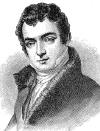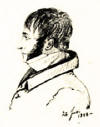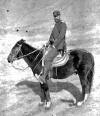Thanks to research undertaken by Professor Dr. Georg Jäger at the Ludwig Maximilians Universität in München, Germany, the Guild has learned of the important journey made by Daniel Chodowiecki, a renowned 18th century Polish artist and Historical Long Rider. Though he spent most of his life in Berlin, after a thirty-year absence, Chodowiecki decided to ride back to Danzig (Gdañsk) in Poland, where he had been born. His book, Journey from Berlin to Gdansk ("Die Reise von Berlin nach Danzig") was published in 1773. It not only preserves vital details of how European equestrian travel was undertaken in that era, the volume contains accurate images depicting the Long Rider and his horse on the road. Thanks to Chodowiecki’s ride, Long Riders from Germany and Poland have been inspired to open an international trail which will encourage equestrian travel between the two countries.
Historical Long Rider Edward Dodwell is the ancestor of the modern Long Rider Christina Dodwell. Before he became an equestrian explorer, Dodwell was an officer who was captured by the French during the Napoleonic Wars. He was granted parole, provided that he did not return to Britain to fight again. This prompted Dodwell to set off in 1801 to ride through Greece instead. He spent the next five years searching for architectural evidence of Greek’s classic period. In addition to writing about the wonders of that lost world, in his book Dodwell also made keen equestrian observations. For example, he recalled how his pack horse fell into a stream, thereby damaging the beautiful paintings he had painstakingly done of the ancient buildings. Ever the student of architecture, Dodwell also recorded how the Greek Orthodox churches were intentionally built with doors so narrow as to only allow one person to pass through. This was designed to deter Turks from turning the churches into stables.
But the Irish Long Rider’s most significant equestrian discovery was that despite the passage of centuries, the distances he travelled on horseback matched those made by Greek scholars who had ridden the same roads centuries before.
“Distances in Greece are not regulated by measure, but computed by time. The Tatars, who travel on small and fleet horses, without any encumbrance, except their pipe and tobacco bag, pass over rocks and mountains, through forests, swamps, and trackless wilds, with a truly astonishing velocity. They accordingly use a totally different method of computation from that which is commonly adopted in Greece by those who travel with luggage horses, which are calculated to go throughout the day's journey, at the average pace of three miles an hour ; but from this rate, some deductions must be made in mountainous roads. This rough kind of calculation is more accurate than might be imagined. The Author, during his journey, measured all the distances by this method, and comparing the result with the Greek historian Strabo (64 BC) and the Greek traveller Pausanias (200 AD ), he had the satisfaction to find, that the difference was frequently very immaterial.”

Washington Irving is best remembered today as being the author of “Sleepy Hollow” and “Rip van Winkle.” He was also a resolute equestrian traveller. Born in New York, the young man’s sense of adventure was fuelled by reading “Robinson Crusoe.” When ill-health prompted his wealthy family to offer him a chance to make the “grand tour” of Europe’s capitals, he departed without regrets. Irving spent the next seventeen years travelling, riding and writing in Europe. His elder brother criticized the author for his penchant “to gallop through Italy,” all the while ignoring the popular tourist spots. The roaming writer visited France, the Netherlands, Spain, Scotland, Wales, and England. Irving’s book, “Tales of the Alhambra,” later inspired English Long Rider George Cayley to make his own ride through Spain in the 1850s.
Tadeusz Kotwicki completed several remarkable rides. In 1992 he rode an Akhal Teke 4,000 kilometres from Jambyl, Kazakhstan to Moscow, Russia. Beginning in 1995 he began a journey in Patagonia, planning to continue all the way to the Bering Straits. During his passage through Peru, Kotwicki was savagely attacked by Indians. He was saved thanks to the chance passing of a public official. Ironically, this attack matches one made a few years earlier, when Indians in this same area nearly killed Russian Long Rider Vladimir Fissenko. Both men were believed to be mounted demons intent on eating the natives. The Polish Long Riders’ trip concluded in 1998 when he reached Kansas.
Ole Olufsen made two mounted explorations of the Pamir Mountains in 1896 and 1898. He was assisted by the Emir of Bokhara and travelled peacefully among the Kirghiz and Tajiks residing in the remote valleys. Olufsen was interested in documenting the high alpine lakes in the Pamirs. During his journey Olufsen made a number of interesting cultural observations, including the Kirghiz belief that a breed of mythical seahorses lived in these isolated lakes. These strange horses supposedly emerged from beneath the waves at night, whereupon they began grazing and breeding with the local horses who resided on land. When his journey was concluded, the Danish Long Rider was honoured by Czar Nicholas in St. Petersburg, on his way home to Copenhagen.
Susanna Carson Rijnhart was a Canadian Long Rider who not only suffered tremendous emotional heartache, she had to protect herself against sexual predators when she was most vulnerable. Carson had been practising as a doctor in Toronto for six years when a Dutch missionary named Petrus Rijnhart arrived in 1894 to discuss his work along the dangerous border between China and Tibet. The charismatic Rijnhart made such an impression on Susie that they quickly married and she returned with him to China.
After having settled in a remote part of China, they leaned Tibetan. Their intention was to ride to Lhasa, which had not been visited by Westerners since 1846. In November, 1897 Swedish Long Rider Sven Hedin visited their home on his way out of the “hermit kingdom.” The tough explorer praised Susie’s medical work, noted that she wore local clothes and had befriended many locals.
The Rijnharts departure was delayed by the birth of their son, Charles, in June, 1897. But less than a year later, in May, 1898, Susie and Petrus set off for Lhasa. The elusive capital was nearly a thousand miles away. In between lay hostile tribes, soaring mountains and an aggressive climate. No matter. They hired two Chinese men as servants, employed a reliable Ladakhi as a guide, packed supplies, Bibles and baby Charles onto the pack horses, then set off into the unknown.
Alas, religious purity wasn’t enough to protect their dreams. The Chinese servants deserted. Their pack horses were stolen. Baby Charles died. The guide quit. Only a hundred miles from Lhasa, the Tibetans blocked their progress and ordered the weary Long Riders to return to China. Then things really got bad.
Having struggled through an early September snow storm, Susie and her husband were attacked by bandits. Most of their horses and the majority of their remaining possessions were lost. Because of their desperate situation, Petrus left his wife to seek help from Tibetans camped on the far side of a raging river. He was never seen again.
Susie Carson had come a long way from Canada. Now she was left in Tibet with nothing except a revolver, some silver bullion and her faith. She rode on. Eventually Susie was able to engage Tibetans to act as guides but they attempted to rape her. The beleaguered Long Rider held them off with her pistol then pushed on alone. After crossing numerous mountains, Susie arrived back in China frost-bitten, penniless and in rags. She had been gone six months.




